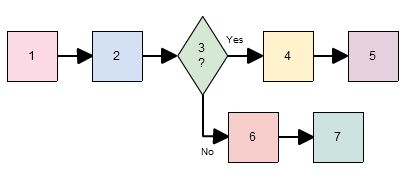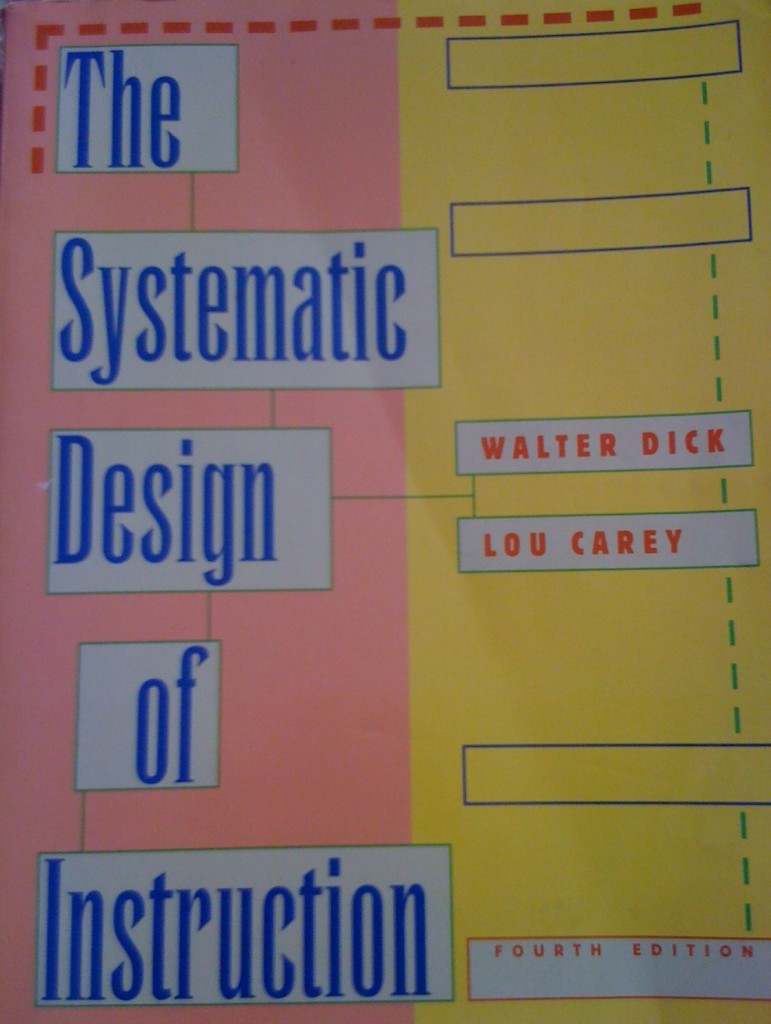I love Japanese Pizza, but…
…Pizza Hut Japan, you’ve got to be kidding me:
Please keep your “mini dogs” and their ketchup away from my mayonnaise and corn pizza!
SDoI: Chapter 3: Conducting a Goal Analysis

Goal Analysis Diagram by Elizabeth Lavolette is licensed
under a Creative Commons Attribution 3.0 United States License.
[This is the fourth in a series of posts about Dick and Carey’s The Systematic Design of Instruction. Want to read an overview and my thoughts on Chapter 1 and Chapter 2 before proceeding?]
Chapter 3 starts out strong, including this sentence on page 34:
This content approach stresses knowing, whereas the instructional design approach stresses doing.
Yes! That’s exactly what I want in an approach. If I am designing a language course, I don’t want students to know facts about the language; I want them to be able to, for example, communicate with people using the language. (Although knowing facts, such as the meaning of words, is clearly part of being able to communicate in a language!)
The middle of the chapter is showing its age. (I am reading the fourth edition, copyright 1996.) It’s all about making diagrams to represent goal analyses – without a single mention of computer tools to simplify this! I made the diagram above using Cacoo, a free web app that make it very simple to create such diagrams.
On page 39, I was surprised to read that
As a general rule, at this stage, you would typically have at least five steps but not more than fifteen for one to two hours of instruction.
I do not disagree with this statement, but I was surprised to see definite numbers suggested, even such a wide range. And of course, this is limited to the typical situation, so there are always exceptions.
Also on page 39, I had another surprise:
One special note should be made about the goal analysis of a verbal information goal. . . . In a sense, there is no intellectual or psychomotor procedure other than the presentation of a test question and the retrieval of the answer. . . . Therefore, the goal analysis indicates only the specific cues the learner might use to retrieve the desired information, but there is no sequence of steps per se.
From one point of view this is a relief to me: Those in the field of instructional design have not found some secret way to teach verbal information (such as foreign/second language vocabulary) that I have been unaware of all this time. On the other hand, if only they had!!! I am still hoping to find something earth-shattering in this book that I can bring to my design of language courses, but I will be happy with simply learning the Dick and Carey system.
A couple of further notes about the summary at the end of the chapter:
The goal analysis process is begun only after you have a clear statement of the instructional goal. The first step in the goal analysis is to classify the goal into one of the four domains of learning. It will be either an attitude, an intellectual skill, verbal information, or a psychomotor skill. (p. 46)
So, this implies that no goal can be a combination of different skills – or if it is, you have not stated the goal clearly enough. I’m going to keeping thinking on this point as I read the rest of the book, but my gut reaction is that this is an oversimplification. What about a seemingly straightforward goal like “Students will be able to introduce themselves in Japanese in a culturally appropriate manner”? I immediately see the necessity to learn words (or at the very least, set phrases) in Japanese, i.e., verbal information; grammar (at the very least to know where in the phrase to insert your name), i.e., an intellectual skill; and cultural norms of which phrases to use with which interlocutors – perhaps more verbal information, but requiring a certain attitude in order to be put to use.
Finally, I have a question about this statement on page 47:
When there is no natural chronology among the steps, however, they should be sequenced based on the inherent relationships among them, for example, spatial, easy to complex, familiar to unfamiliar, common content areas, and so forth.
Why? I don’t disagree with this statement – in fact, it seems quite natural to arrange things this way. But I’d be interested to see some research in this area. I seem to recall reading a study that found that participants had more trouble learning the meanings of foreign words when synonyms and antonyms were taught together than when they were taught in differently arranged groups, but I do not remember the details. Anyone out there have some insight?
SDoI: Chapter 2: Assessing needs to identify instructional goal(s)
[This is the third in a series of posts about Dick and Carey’s The Systematic Design of Instruction. Want to read an overview and my thoughts on Chapter 1 before proceeding?]
This chapter is mainly about writing goals for instruction. However, before getting too excited about designing instruction,
Note that while an instructional designer may participate in a needs assessment study, there is no assumption that part or all of the solution will be instruction. (p. 18)
This make a lot of sense, keeping in mind that instruction might not be needed, even if someone in charge thinks that it’s the solution. Thus, I think that it might be inappropriate for an instructional designer (ID) to be the only person doing a needs assessment. That is, the ID might have too much stake in instruction being the solution and should instead work with a team to assess the need. A disinterested third party might also be appropriate.
Throughout this chapter are statements about how the ID should clarify and restate goals, such as the following from p. 17:
Typically, the goals used by an instructional designer have been derived from some type of needs assessment, either formal or informal, and have been further refined by either a job or curriculum analysis.
In fact, we learn on p. 19 that
Many goals are fuzzy, and designers must learn how to cope effectively with a “fuzzy.”
Puts me in mind of a warm fuzzy, which really sounds like a good thing! But not so when writing goals. Much as it may be important for IDs to write clear (“unfuzzy”? “defuzzed”?) goals, a very important point is made on p. 20:
Powerful people often determine priorities, and finances almost always determine the limitations of what can be done on an instructional design project.
Ah, reality. This sounds more like the world I am accustomed to, where goals are not carefully crafted so much as dictated and fudged. I do like the sound of this ideal world described in the chapter, though.
One thing I find lacking in this chapter is a consideration of how to apply the identification of goals in academia. In the chapter summary on p. 27, we read
Questions you should answer about the problem and need include whether:
- The need is clearly described and verified.
- The need is foreseeable in the future as well as presently.
- The most effective solution to the problem is instruction.
- There is logical agreement between the solution to the problem and the proposed instructional goals.
- The instructional goals are acceptable to administrators and managers.
Starting with “question” 1, in education, the need is often assumed to exist – it cannot be clearly described or verified. Of course, there are exceptions, but if we consider, for example, a math class required for humanities majors or an introductory foreign language class, the students who take the class may have no immediate or foreseeable need to use what they are learning. This makes question 3 invalid.
I’m ready to read Chapter 3: Conducting a Goal Analysis.
SDoI: Chapter 1: Introduction to Instructional Design
I’m working my way through The Systematic Design of Instruction (SDoI), 4th ed., by Dick and Carey, and here are my thoughts on Chapter 1: Introduction to Instructional Design. (You may get the impression from this post that I’m disagreeing with what the book says, but for the most part, I’m not. I’m just not writing about those parts – boring!)
I feel a bit like Alice while reading this chapter.
Once or twice she had peeped into the book her sister was reading, but it had no pictures or conversations in it, “and what is the use of a book,” thought Alice, “without pictures or conversations?” (Alice’s Adventures in Wonderland by Lewis Carroll)
I am clearly spoiled by the Internet, with its interactivity and colors and lolcats. But I am having a hard time remembering how, as an undergrad, I stayed awake when reading textbooks without any pictures or even pull quotes. (I do remember nodding off quite a bit…) Seriously, this text is DRY. And shouldn’t it be itself an example of good instructional design? Despite that, I will try to focus on the points it is making.
On page 10, we learn that
The beneficiary of the application of the systems approach to the design of instruction is the individual learner.
I feel like I’m being tricked by this statement. I would think that, assuming that we are designing instruction for a group of learners, rather than just one, the beneficiary of the use of the systems approach is the group of learners, not the individual. That is, when using the systems approach, we hope to most effectively and efficiently benefit as many learners in the group as possible, but we do not necessarily produce instruction that is the most beneficial to an individual learner. As I understand it from this chapter, the systems approach necessarily takes the view that the group of learners is homogeneous in terms of knowledge background and a range of other factors. And that is simply not true in most cases.
Later in the same paragraph, we find that
The learner is evaluated fairly with instruments that measure the behaviors described in the objectives, and the data are used to revise the instruction so that it will be even more effective with succeeding learners.
I don’t disagree that evaluating current learners is a good idea so that we can make improvements for future learners. But let’s be honest: Future learners are not the same people are current learners. We can only use the data from current learners to help future learners insofar as the groups behave similarly. I think that this assumption ought to be stated in the text.
Moving on to more practical matters, on page 10, we read
In contrast to the instructor who may be working alone, the instructional designer often works with a team of specialists to develop the instruction. The team would typically include a content specialist, a media specialist, an evaluation specialist, and a manager.
So, if I’m understanding this correctly, the instructional designer is not part of the team? Maybe it’s just a poor choice of wording, but I think that the instructional designer is an integral part of the team, although it need not be a single dedicated person. In the team that I work with, some people have defined roles as the content specialist (SME), media specialist, and manager, but nearly everyone acts as an instructional designer in some capacity, and those who are interested participate in evaluation. Having a defined evaluation expert with specialized skills sounds like a great idea for our team!
Next up? Chapter 2: Assessing Needs to Identify Instructional Goal(s)
The systematic design of instruction
I’ve been working as part of an instructional design team for almost two years now, and I haven’t read The Systematic Design of Instruction by Dick and Carey. (Don’t laugh!) It’s time to correct that.
I came to instructional design not from an education background, but from applied linguistics and teaching English as a second language. So, I had prior experience designing courses, but people in those fields generally talk about “materials development,” not “instructional design,” and I have never heard anyone refer to the systems approach, ADDIE, or Dick and Carey.
So, it’s time to up my game – or at least my instructional design lingo! I bought an older edition of this canonical textbook on eBay for $1.99, and I’m going to read it (however long it may take me!) and post my thoughts on it here.
First, one note about the preface: Wow, how incredibly meta. The preface explains that the book was designed by the authors for instructors to use to teach future instructional designers to design instruction. My head is getting tangled up in that one…
Push the BigBlueButton
When I try a web-conferencing product, I expect to find myself in a sterile demo room – alone and left to my own devices.
When I tried BigBlueButton, I was momentarily confused.
Many people were in the demo room. They were talking, text-chatting, pointing at slides – and one of the developers, Fred Dixon, starting giving me the run down on the features! When I explained my interest in the product, he called me on the phone to give me more information. Fred, thanks for the great work and personal attention!
BigBlueButton worked extremely smoothly in the demo. If you’ve used a web-conferencing system like Elluminate Live! or Dimdim, it’s highly intuitive. Although it does not have as many features as either of those systems, Fred told me that they are coming in future releases. And yes, the developers DO hang out in the demo room all day, and they are happy to tell you more about their product!
For me, the icing on the cake is that BigBlueButton is open source!
(h/t to Free Technology for Teachers)
Origami mail
Today, I got this in my email from a friend. Click it to open it and read the message:
Thanks, Noriko!
How to Become a Book Club
Our book club has chosen yet another book that the great Internets have no discussion questions for!
This time, we’re reading Self Help by Lorrie Moore. Because it’s a book of short stories, we’re focusing on the first one, How to Be an Other Woman.
This story is fairly exemplary of the book as a whole. As most of the stories, it has a rather sad ending and keep you feeling kind of sick for the main character throughout, although it has its moments of joy, too. The atmosphere feels very 1970s.
Here are a few discussion questions. Please help me out by adding to them in comments!
- Why does the author write this story in the second person (i.e., using “you”)? How does that affect the reader’s understanding of the story?
- What does this story say about the ways that men and women go about conducting affairs?
- What is the significance of the lists throughout the story?
-
(Update, 2/3/10) From co-conspirator Annie Cherbony, via Facebook: Let’s discuss our favorite lines from this story. :)
A Wild Sheep Chase
The SOOLG (significant others of literary geeks) book club is kicking off soon, on January 11! Our first book is A Wild Sheep Chase by Haruki Murakami. I really enjoyed this book, but I am completely at a loss as to what it meant and how to discuss it. I am hoping that other people will have some insight.
Since I foolishly volunteered to come up with the discussion questions, I have been scouring the tubes for some help. A few are out there, but not enough. If you’ve read the book, I could really use your help on this! Please, please, help me out by adding to this list in the comments. (Did I mentioned that I didn’t understand this book?)
- The sheep invades several people. What does the sheep represent?
- Why are no proper names (other than “Kipper”?) used?
- What’s up with the whale penis stuff?
- Who exactly is the Sheep Man? What’s he doing there? Why do his words run together when he speaks?
- What do the girlfriends’ ears represent? How are their various powers relevant to the story?
- Women in the story are mainly sexual partners of the narrator (e.g., “the girl who would sleep with anyone”, the ex-wife, the girlfriend). Are they even important to the story?
- What is the meaning of the office that the narrator watches from his room at the Dolphin Hotel?
Netflix is great
No, they didn’t pay me to write this. But they did send me an extra DVD. As they sometimes do. <3










